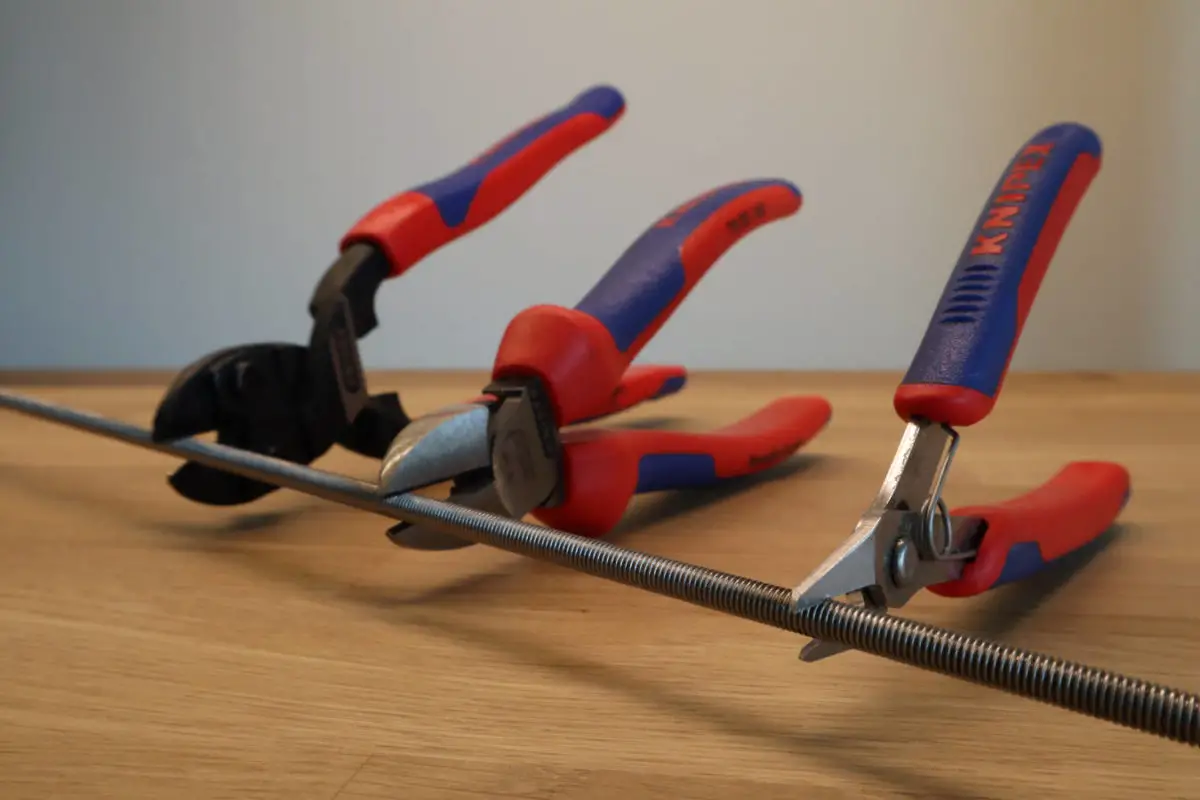Cutting metal wire or similar stock – nails, screws, rebar, wire rope, and so on – is a recurring task in the shop, around the house and at the job site. While the heaviest wire and rod must be cut by sawing or grinding, the frequent small-to-medium gauge cutting jobs are most conveniently achieved using cutting pliers: they are clean, fast and easy to use, and available in a wide range of types and sizes.
Choosing the right pair of pliers for each cut is not always easy, however. For the first, the wires and rods to be cut vary greatly not only in diameter, but also in material strength or hardness, which may be difficult to quickly determine in the field. Second, each pair of cutting pliers has a specific limited cutting capacity, which you should not exceed, or you will risk damaging the tool and even injuring yourself.
In this article, I present an overview of the common types of general-purpose wire cutting pliers and their cutting capacities to help you in this task. For the easiest reference, I have compiled the central information into a cutting capacity chart, which allows you to quickly determine how hard the cut you are making actually is, and which pliers are up to the task. (If you just want the result, jump ahead to the chart.) We will also go through some of the most common questions on cutting capacity and provide a specific answer using the chart. I hope the information presented here helps you to save time, money and pliers.
Cutting by forming
First, it is important to understand that the limited capacity of cutting pliers follows directly from the mode of cutting they employ. As opposed to saws and grinders, which consume the workpiece section away in small chips, cutting pliers operate by forcefully pinching or shearing off the workpiece in a single forming operation.
Compared to cutting by chip removal, this forming operation is advantageous in being clean, fast, non-sparking, relatively safe and almost totally silent. However, it is also a major challenge for the tool, because it involves a simultaneous deformation of the entire workpiece cross section; instead of dealing with the material in a piecemeal fashion, a chip at a time, pliers must be able to rupture all or most of the cross section at once.
The demands put on the pliers by this mode of cutting can be broken down to two independent requirements. To be able to make the cut, the pliers jaws must
- perform the pinching or shearing action with a high force to win out the wire section strength, and
- have a cutting edge harder than the wire material to be cut to sustain the large local stresses without deformation.
These requirements ultimately place limits on both the thickness and hardness of the wire that can be cut with a certain pair of pliers. Knowing these limits and sticking within them is important for efficient and safe cutting: on the one hand, trying to cut wire that is too thick or hard for the pliers will not only not work, but is also very likely to permanently damage the tool, and may even cause injury. While safe, using large-capacity pliers on easy cuts, on the other hand, is also not optimal, as these pliers will be bigger, heavier, clumsier and more expensive than a pair of more reasonably-sized cutters.
Ideally, you should be able to find out the cutting capacity of your pliers by checking the manufacturer’s specifications. The capacity is typically stated as a maximum wire diameter that the pliers can cut in one or more wire strength classes. However, the data given out, even by reputable manufactures, is often not very comprehensive, with capacity reported only for one or two wire strength classes, or in many cases for none at all. Further, even when capacities are reported, the wire strengths may be expressed in qualitative terms such as ‘Fe+’ or ‘hard wire’, which are difficult to interpret.
Taking a step back, the main questions on cutting capacity that the user wants answers for can be boiled down to two types:
- What kind of wire can a certain pair of pliers cut?
- Which pliers can cut a certain wire?
The manufacturer’s specifications go some way in answering questions of the first type. From a practical point of view, however, questions of the second type are more central. I have been unable to find any online resource that would address this kind of questions in a comprehensive manner.
Cutting capacity chart
To allow such questions to be quickly and easily answered, I decided to compile a summary table of the typical cutting capacities of general-purpose cutting pliers: bolt cutters, compact bolt cutters, diagonal cutters of different service grades, and flush cutters. For this, I went through all the available data from different manufacturers, combined it by pliers type and size, harmonized the units, and averaged the results. Although a substantial dose of engineering assumptions was necessary to interpret the manufacturers’ specifications and to fill out the gaps, this combination strategy allowed me to form an overall picture from the sparse specification data.
The results are presented in a cutting capacity chart below. The chart presents the maximum permissible wire thickness–strength combinations for the common types and sizes of cutting pliers, with the wire/stock thickness on the vertical axis and the hardness on the horizontal. For easy reference, both the thickness and hardness axes are drawn with multiple scales and both in metric and US customary units. Since wire hardness is difficult to measure in the field, I have also supplemented the chart with hardness indications for the most common wire stock on the horizontal axis.
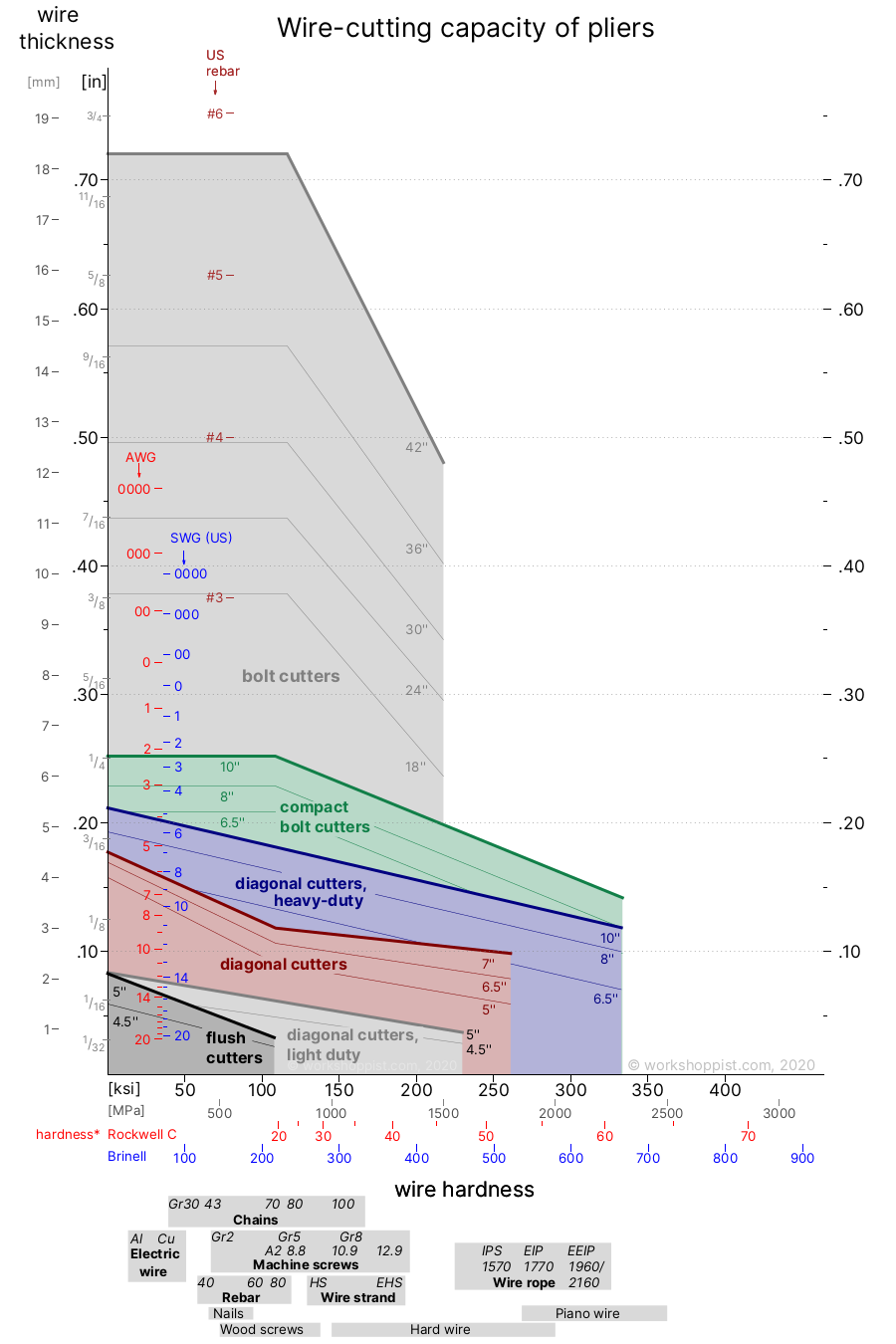
Although the chart is self-explanatory, some notes are in order. First, the chart includes only the most common types of cutting pliers; many less common or speciality cutting pliers were omitted for clarity. This includes notably all of the various cutters specifically intended for cutting stranded material. Second, the chart is based on the manufacturer-specified cutting capacities, not on actual measured performance. While in some product classes, the user experience does not always meet the manufacturer’s promises, I have found these numbers rather conservative than exaggerated. Third, the performance reported for a very similar pair of pliers by two manufacturers sometimes differed significantly, particularly for harder wires. It is hard to say whether this reflects a difference in actual performance or in reporting standards. Finally, the chart should be used only for indication of typical performance; before attempting a cut, be sure to check that your specific pliers model is up to it.
Cutter types
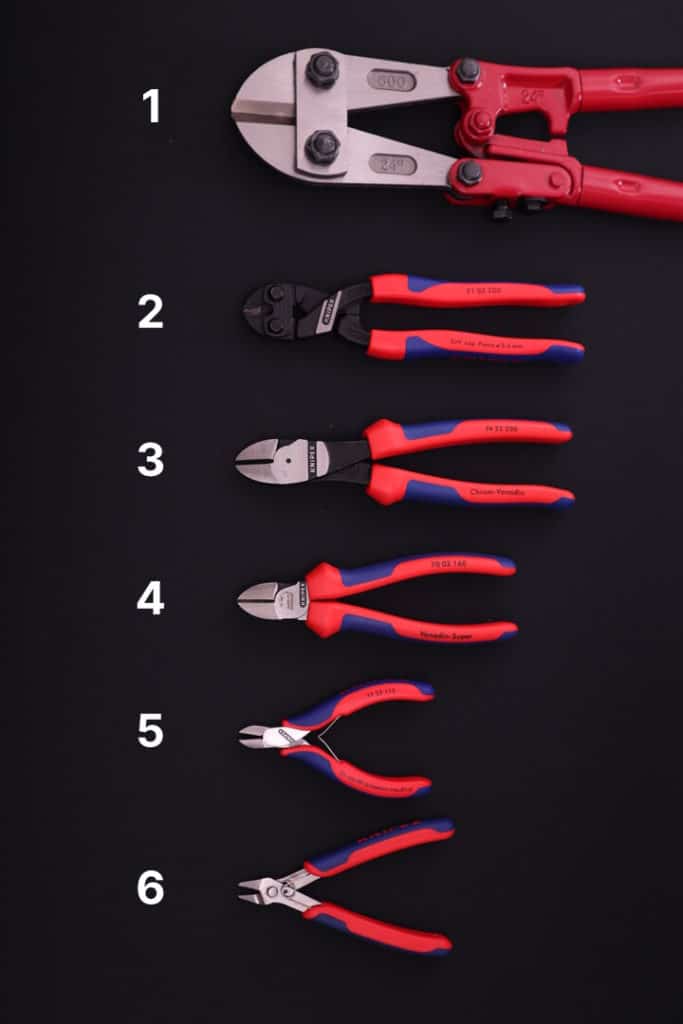
The types of cutting pliers featured in the chart are:
- Bolt cutters: Heavy straight-jaw center cutters, 14”–48”, with compound action. Two-hand operation, largest of the common cutting pliers. Specified for bolts and other heavy rods up to around 45 HRC.
- Compact bolt cutters: Small straight-jaw center cutters, 6½”–10”, high leverage, external tie joint. Mainly single-hand operation. Cutting edge hardness up to 64 HRC, suited for very hard wire.
- Diagonal cutters, heavy duty: Diagonal cutters, “heavy-duty” or “high-leverage”, 5½”–10”, of particularly robust construction. Mainly single-hand operation. Cutting edge hardness up to 64 HRC, suited for very hard wire.
- Diagonal cutters: Diagonal cutters of standard construction, 5½”–10”. Single-hand operation. Cutting edge hardness up to 60…63 HRC, suited for hard wire.
- Diagonal cutters, light duty: Small diagonal cutters of fine construction, 4½”–5½”, for electronics or fine mechanics work. Often soft cutting edges, low to zero bewel, polished. Suited for medium-strength wire.
- Flush cutters: Small diagonal cutters of very light construction, 5”–5½”, for very light duty in electronics or jewelry. Zero bewel for precise flush cuts. Only for soft wire.
In addition to the cutting pliers displayed on the chart, many gripping pliers include cutting jaws, and can be used to cut wire. In terms of specified cutting capacity, combination pliers are on par with diagonal cutters (4), and heavy-duty combination pliers or Lineman’s pliers with heavy-duty diagonal cutters (3), although the cutting edges may not always be quite as hard. Finally, snipe nose and flat nose pliers typically fall between light and standard duty diagonal cutters (4-5) in cutting capacity.
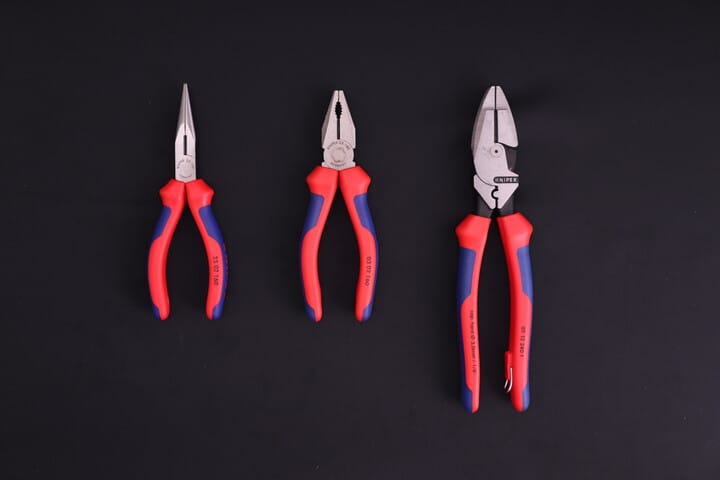
Some of the less common or speciality cutters that were excluded from the chart also deserve mention:
- Center cutters: similar to diagonal cutters, 8”–10”, but with symmetric cutting edges on the center line; equal or slightly higher cutting capacity, but no flush cutting. Also called center cut pliers.
- End cutters: light to medium duty cutters, 5½”–10”, cross-wise cutting edges. Optimal for cuts flush to a surface where lateral space is restricted. Also called end nippers, end cutting nippers, cross cutting pliers. Similar to pincers.
- Wire rope cutters: speciality cutters for wire rope and cable, 6”–36”, shearing action, hooked jaws to reduce wire head distortion and splaying. Cutting edge hardness up to 64 HRC, suited for very hard wire. Possibly ratchet action.
- Cable shears: speciality cutters for Al- or Cu-conductor electric cable , 6”–37”, shearing action, hooked jaws to reduce cable flattening. For soft wire only. Possibly ratchet action.
Common cutting tasks
Now, let us go through some common cutting capacity questions and answer them using the chart:
Which pliers are suitable for cutting hard wire?
While there is no exact definition of what is “hard” wire, the term commonly refers to wire with a tensile strength above 150 ksi (1000 MPa) or a hardness higher than around 35 HRC or 300 HB. As indicated in the chart, such wire can be cut using diagonal cutters (3-4), compact bolt cutters (2) and bolt cutters (1), depending on the wire diameter. However, only heavy-duty diagonal cutters (3) and compact bolt cutters (2) are typically specified for very hard wires above 250 ksi (1750 MPa); if you are not sure how hard the wire is, stick to pliers specified for “piano wire”, which is the hardest common grade. Remember that trying to cut wire too hard for the pliers will damage the tool permanently.
Which pliers are suitable for cutting piano wire?
With a tensile strength often exceeding 300 ksi (2000 MPa), piano or music wire is the hardest common grade of steel wire, and places very high demands on the hardness of the cutting edges in the pliers jaws. As seen on the chart, only compact bolt cutters (2) and heavy-duty diagonal cutters (3) are typically specified for cutting piano wire. Some of the less common or speciality cutters, such as center cutters, end cutters and wire rope cutters, as well as the cutting jaws on some heavy-duty combination or Lineman’s pliers may also be up to the task, but be sure to verify the capacity in the specifications – piano wire will easily dull or dent even moderately hardened cutting edges.
Which wire cutters are the best for jewelry?
The metal wires used in jewelry are mostly made of soft materials: silver, copper, nickel, gold, coated mild steel and stainless steel, all with a tensile strength below 100 ksi (750 MPa) in the common alloys. In addition to being soft, most of the wires are also thin gauge, below 1/8”, 8 AWG or 3 mm. The majority of the jewelry cutting tasks therefore lie at the lower left corner of the chart, and can capacity-wise be accomplished using any cutting pliers. Due to the detailed and precise nature of the work, jewelry makers are still best served by flush cutters (6), which allow accurate aiming and leave a very clean cut, complemented with a pair of light (5) or standard duty diagonal cutters (4) for the occasional heavier cut.
Which pliers cut wire rope (and cable)?
Commercial wire rope is laid of steel wire that ranges from hard to very hard. As indicated on the chart, the maximum tensile strengths of the wires range from 250 ksi (1750 MPa) for the softest 1570 and IPS grades to well above 300 ksi (2000 MPa) for the hardest EEIP and 2160 grades. Although the stranded construction of wire rope lowers the peak cutting force compared to a solid rod, the high strength of the individual wires requires very hard cutting edges on the pliers jaws. Of the general-purpose cutters featured in the chart, compact bolt cutters (2) and heavy-duty diagonal cutters (3) can be used to cut small-diameter wire rope of all grades, but only up to a modest thickness of around 1/4”. While bolt cutters (1) can be used for thicker wire rope, their cutting edges are specified only for the softest grades, limiting their utility in the application.
Overall, the general-purpose cutting pliers are not really optimal for the combination of high material strength and relatively large diameters encountered in wire ropes. They also tend to flatten the rope ends on cutting, which complicates rope finishing and handling. Instead, wire rope is best cut using purpose-built wire rope cutters, which shear rather than pinch the rope and have hooked jaws to reduce splaying.
Which cutters for EHS guy strand/wire?
The hardest common EHS grade (Extra High Strength) of guy strand (also guy wire, wire strand) is laid of galvanized hard steel wires with a tensile strength around 175 ksi (1250 MPa). Despite the name, even the hardest guy or wire strand is thus softer than all of the wire rope grades, and is not particularly demanding for the pliers cutting edges. Nevertheless, EHS strand is still moderately hard, and with common gauges between 1/4”…1”, its thickness makes it challenging to cut. Out of the general-purpose cutters in the chart, compact bolt cutters (2) should be able to cut the smallest guy strands up to around 1/4”, and bolt cutters (1) strands up to somewhere between 5/8” and 11/16”. As wire rope, guy strand is still best cut using hooked-jaw shearing wire rope cutters or special notched guy strand cutters, both of which reduce strand flattening and provide an improved capacity-to-size ratio.
Which cutters for bike cable?
Bicycle brake and shift cables, though only .063” and .047” (1.6 mm and 1.2 mm) in diameter, respectively, are made of very hard galvanized or stainless steel wire, making them challenging to cut. Although the manufacturers rarely specify the actual wire strength, it is probably similar to the heavier-gauge commercial wire rope rated at 230–310 ksi (1500–2200 MPa). This asumption is supported by my own testing, where I have found the individual bike cable strands to dent 54 HRC cutting edges (see image below), but leave 61 HRC edges intact.
Looking at the chart, only heavy-duty diagonal cutters (3) and compact bolt cutters (2) are typically specified for wires this hard. While these pliers can be used to cut bicycle cable, they tend to distort and splay the cable end, making rerouting into housing difficult. For optimal results, bike cables should instead be cut using purpose-built light-duty wire rope cutters.
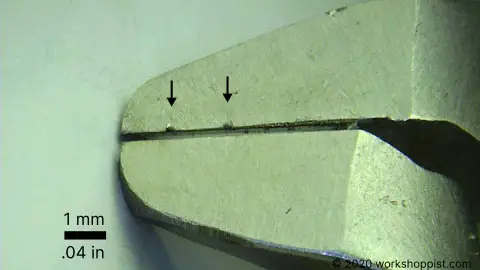
Which pliers for cutting chain link fence?
Most chain link fence is made of 11.5 to 9 gauge (SWG US, blue inset scale) cold-drawn mild steel wire with a moderate tensile strength below 100 ksi (700 MPa).
As shown on the chart, chain link fence wire can be cut with standard or heavy-duty diagonal cutters (3-4) and compact bolt cutters (2). Heavier 6 gauge wire sometimes employed in high-security installations requires compact bolt cutters (2) or bolt cutters (1). Possible zinc, aluminum or plastic coatings do not significantly increase the cutting effort.
Can you cut rebar with bolt cutters?
Yes, bolt cutters can cut rebar. As indicated on the chart (brown inset scale), US #3 rebar should go with most 18” bolt cutters, #4 with 30” cutters, and #5 with 42” cutters – these hold for all common rebar grades 40–80. While you may still be able to cut a #6 rod with a pair of exceptionally large cutters, such capacities do not seem to be advertised by any manufacturer. Cutting rebar with bolt cutters does take some physical effort, but is cleaner, faster, quieter and safer than sawing or grinding. For easy reference, the bolt cutter size for each rebar is summarized in the table below.
| US rebar size | Required bolt cutters |
|---|---|
| #3 | 18” or larger |
| #4 | 30” or larger |
| #5 | 42” or larger |
| #6 | N/A |
Which pliers can cut remesh?
Remesh or concrete reinforcement mesh is typically low-carbon or stainless steel wire in the rebar strength grades 40–80, with tensile strength between 60–100 ksi (400–700 MPa).
As seen in the chart, remesh wire of this hardness can be cut using diagonal cutters (3-5), compact bolt cutters (2) or bolt cutters (1), depending on diameter. Standard-duty diagonal cutters (4) will cut the smallest typical remesh wire, which is 10 gauge SWG, W1.4 (W9.1 metric), or roughly 1/8” (3.4 mm) in diameter. Heavy-duty diagonal cutters (3) cut up to gauge W2.9 (W18.7 metric), and compact bolt cutters (2) up to the largest common gauge W5.4 (W34.9 metric). Finally, bolt cutters (1) can handle even the rarer heavy remesh rods all the way up to gauge W18.9. Special remesh cutters with improved ergonomics are also available to reduce operator strain in the repetitive task.
Which pliers can cut fish hooks?
Fish hooks are usually made of hardened high-carbon or alloy steel wire with tensile strengths 150–300 ksi (1000–2000 MPa), or of somewhat softer stainless steel wire. Although the hooks used in sports fishing are relatively thin, the high material strength makes them tough on the pliers cutting edges and consequently difficult to cut. As indicated on the chart, only heavy-duty diagonal cutters (3) and compact bolt cutters (2) are typically specified for the entire hook hardness range – to avoid denting the cutting edges, you should stick to these pliers if you are unsure of the hook hardness. Some speciality fishing pliers with tungsten carbide cutting edges may also be used to cut small-gauge hooks, but their light construction prevents their use on heavier hooks; before attempting a cut, be sure to check the manufacturer’s capacity specification. Remember that trying to cut wire too hard or thick for the pliers may damage the tool permanently.
Which wire cutters for electronics?
Electronics work involves cutting solid and stranded copper or aluminum conductors up to roughly 14 AWG as well as mild steel or copper through-hole component leads up to around 1/32”, 18 AWG or 1 mm. As indicated on the chart, the very low strength and modest gauge of these wires makes the cutting tasks relatively undemanding, and as such suited for all cutting pliers. Cutting multicore cables, such as power cords, extension cords and networking cable, up to a diameter of 5/16” (8 mm) may also be necessary occasionally, but being mostly soft polymer insulation, they present no particular challenge for the pliers.
While cutting capacity is not an issue, many of the cuts in electronics have to be accomplished in tight spaces, with high precision, or flush to a surface; similar to jewelry, electronics workers are best served by a combination of flush cutters (6) for fine cuts and light or standard duty diagonal cutters (4–5) for the heavier cuts.
Which cutters for padlock?
Most common padlocks models can be cut using bolt cutters. While this may damage the cutters and is not recommended practice, an understanding of the possibilities is important in planning of property security and of forcible entry in emergencies. Determining the cutter size required for a given lock is not possible with certainty, but some rough guidelines can be given – see table below.
As with other types of wire and rod, the cutting resistance of a padlock is determined by the thickness and hardness of its shackle. The shackle thicknesses range from 1/4” to 11/16” (5…18 mm), with the vast majority of consumer locks between 9/32” and 7/16” (7…11 mm). The shackles are typically hardened steel or hardened alloy steel, which range from moderately hard to very hard; stainless steel is used in locks for harsh environments.
How hard the shackles exactly are is not easy to tell, however, and this makes estimation of the cutting resistance difficult. The lock manufacturers do not usually report the material strength or hardness, and the material descriptions given out encompass too wide a range of possible strengths to convey exact information. ‘Hardened steel’, for example, could in principle have a tensile strength anywhere between 100 and 350 ksi (700…2300 MPa); commonly advertized ‘special alloy’ is even more ambiguous.
Some information on cutting resistance can nevertheless be gained directly from the standard tests that a given lock model has passed. The most advertised one is the standard EN 12320, which describes a cutting force that the lock shackle has to withstand to be certified to a certain security class in the standard.
Comparing the EN cutting test forces to the estimated maximum forces for each bolt cutter size allows one assess which bolt cutters may be able to cut a given certified lock. The table below presents these cutter sizes for the common shackle diameters, assuming hardened alloy steel as shackle material. Note that the indicated size is not exact, but the smallest that probably has a substantial chance of making the cut.
| shackle D [in] | [mm] | bolt cutter size [in] | EN class |
|---|---|---|---|
| 1/4” | 6.4 | 24” and larger | – |
| 9/32” | 7.1 | 30” and larger | 2 |
| 5/16” | 7.9 | 36” and larger | 3 |
| 3/8” | 9.5 | 42” | 4 |
| 7/16” | 11.1 | – | 4 |
| 1/2” | 12.7 | – | 5 |
| 9/16” | 14.3 | – | 5 |
| 5/8” | 15.9 | – | 6 |
| 11/16” | 17.5 | – | 6 |
Finally, it should be emphasized that, as you can verify on the cutting capacity chart, bolt cutters are not really specified for cutting materials as hard as the hardened alloy steel in high-security padlock shackles. Although they may be able to do the cut, you are probably operating them beyond their specifications. This may lead to denting of the cutting edges or even splintering of the cutter jaws. Such failures carry a risk of injury, so you should avoid using bolt cutters for padlocks, and most other locks too. If you absolutely have to attempt a cut, exercise care and wear appropriate personal protective equipment.
